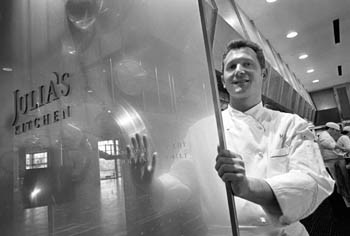Wild Child
Canteen ambiance mars fine cuisine at Julia’s Kitchen
By Paula Harris
One way to attract SUV-loads of salivating visitors to your brand new restaurant is to name it after Julia Child, that heavy-boned American food icon who has been dubbed the patron saint of the pantry. That’s what Napa’s new tourist magnet, the American Center for Wine, Food, and the Arts (COPIA), a $55-million foodie paradise, has christened its gourmet dining room. And the famous moniker seems to be bringing in diners by the drove.
But hold on to your potholders–don’t expect to catch a glimpse of the gourmet grande dame here. Child’s donated personal collection of copper cookware, on display at the center, is probably the closest you’ll get to the beloved chef.
Although she’s bestowing her name to a commercial enterprise for the first time, the 89-year-old Julia Child (who also serves as a trustee to COPIA, jumping on the Robert Mondavi-driven bandwagon with other icons Alice Waters and Martha Stewart) is not in attendance.
The cooking at Julia’s Kitchen is done by Mark Dommen, who has worked at San Francisco’s Fleur de Lys and New York’s Lespinasse.
Dommen focuses on creating upscale French-Californian dishes using regional and seasonal produce, especially produce and herbs from COPIA’s 3 1/2-acre landscaped organic gardens located outside the sprawling 80,000-square-foot building.
Although COPIA is surrounded on three sides by the scenic Napa River, and though the views of water, gardens, and rows of newly transplanted mature olive trees are picturesque, the center is surprisingly harsh and plain inside.
Julia’s Kitchen, despite the cozy name, is no less industrial. With its narrow open kitchen, sharp-edged decor, cold stainless-steel touches, gray concrete floor, and high noise level, the place resembles a busy office canteen rather than a premier restaurant.
There are big overhead lamps and pale green walls. The only softness comes from the heavy white tablecloths. The prep kitchen, which includes a tile installation in shades of blue by renowned contemporary artist Jorge Pardo, can be seen in glimpses though a swinging door–and it seems more aesthetically inviting than this spare dining room.
That’s one strike against Julia’s. The other is that, although the restaurant offers a highly touted chef’s tasting menu featuring five courses for $55, or $75 with wine pairing (lunch prices), they are only capable of offering it to entire tables and can’t accommodate vegetarians.
When my vegetarian companion offered to pick veggie items from the regular menu, I thought I would get the tasting menu but was rather snootily told the chef couldn’t accommodate a vegetarian on the tasting menu. This seems ludicrous in a top-class destination restaurant such as Julia’s.
Still, despite the drawbacks, the food is noteworthy.
A roasted onion and saffron soup ($10.50) arrives without liquid, just chubby, curled rock shrimp, tiny pearl onions, and fresh, snipped chives in the bowl. The server pours in the steaming, creamy soup from a silver teapot. The effect is like drinking velvet and silk with a rich salty tang from the saffron and shrimp. Comfort city!
The baby beet salad ($10.50) makes great use of the garden treasures and is composed of small, very sweet beets, frisée, and curly cress, plus warm chèvre cheese, candied walnuts, and sherry wine vinaigrette.
Hungrier visitors may prefer the sunchoke risotto appetizer ($11), which is a creamy, delicate delight featuring Jerusalem artichokes cooked with arborio rice and enlivened with hazelnuts, garlic, chives, and parmesan cheese.
A roasted monkfish ($19.50) is a sturdy seafood entree accompanied by rabe, applewood smoked bacon, and meaux mustard vinaigrette. Very tasty, although I question the recommended glass of Zinfandel with this dish.
For the ultimate in tenderness, try the braised veal short ribs and delicate sweetbreads ($21). The dish boasts butterlike meat with the sweetbreads crisply fried, plus turnips, rutabagas, celery root, and carrots. My one quibble is that it just tasted too salty.
One of the most exciting vegetarian dishes–both visually and gustatorily–that we’ve seen in a while is the roasted winter squash skewer ($16.50). The thick and colorful slabs of various garden-fresh squashes resemble a shelf of tiny books on their skewer.
A tiny trio of crème brûlées in vanilla, coffee, and chocolate are all chilled, smooth, and ultra intense–but the vanilla wins my vote.
Julia’s Kitchen offers 25 wines by the glass, several wine flights, and a 240-bottle wine list boasting vinos from the United States, Europe, Australia, and New Zealand.
Currently the restaurant is open only for lunch, but there are plans in upcoming months to offer dinner also. In the warm weather, Julia’s Kitchen plans to expand its current seating to outdoor dining.
Center organizers say diners will be able to eat on the paved deck or in the gardens where a wood-fired oven is installed. I would recommend going alfresco and giving the hyperactive dining room a miss.
Julia’s Kitchen Address: Inside COPIA, 500 First St., Napa. 707.265.5700. Hours: Thursday-Monday, 11:30 a.m. to 4 p.m. Plans to open for dinner later in the year. Food: French-Californian Service: Good though rushed Ambiance: Loud, intense noise level and a very sparse and industrial setting Price: Expensive Wine list: Great selection befitting the center Overall: Food 3 stars; ambiance 1 star (out of 4)
From the January 10-16, 2002 issue of the North Bay Bohemian.













